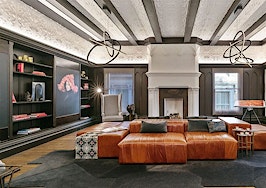Join the exceptional and become a Sotheby's International Realty agent.
Learn More
We’ve all experienced the shift this year: luxury buyers opting for spacious homes in the suburbs or beach houses along the coast over apartments in the city. Yet urban real estate professionals shouldn’t panic: what we’ve seen isn’t a flight from urban density, but a flight of convenience for those who can afford to do so — and for many of them, it will be temporary.
In cities, people are adapting, as they always do in times of change. Here in New York City, we’re accustomed to walkable commutes and active lifestyles. The need to maintain physical distance and minimize unnecessary errands has challenged us, but it has also encouraged us to be creative. Cities have proven that they’re resilient, vibrant locales where homebuyers will still want to live long term.
Establishing separate work zones

Sotheby’s International Realty – East Side Manhattan Brokerage
Urban buyers are looking for different amenities in light of the pandemic. Here in New York City, I’ve noticed a change on my clients’ wish lists: the small rooms formerly known as “maid’s rooms” have suddenly had a comeback. These small suites were often adjacent to the kitchen and were a frequent fixture of prewar apartments in the 1920s. In more recent years, this bonus space has often been renovated and incorporated into larger open-concept spaces. But today, private, secluded areas are a premium for apartment dwellers.
As corporate offices have limited capacity and co-working spaces have closed, professionals are working from home more often — as are students from kindergarten to college. This means that the desire for great rooms and kitchen-dining-family room combinations has lessened, and buyers are attracted to every secluded nook and pocket door you can show them. Even extra-large closets can become a space to make a conference call in peace.
It’s important to highlight detached spaces in your urban listings, as it’s unlikely that professionals will be required to return to their offices full-time in the near future. Nobody had a use for a separate formal dining room before, but now it’s a major feature.
On a related note, my buyers appreciate homes that are amenable to today’s hygiene protocols. Factors that we rarely considered before, such as a powder room and closet off the entrance so you can wash your hands and stow your belongings as soon as you arrive, really enhance the quality of life a home offers in subtle yet salient ways.
Staying fit in finite space
It seems as though each apartment I’ve shown has a Peloton in every room where you can possibly put a Peloton. Unsurprisingly, urban residents are eager to stay active even when they’re being advised to stay home as much as possible and can’t access their building’s fitness center. This means space for exercise is even more essential for apartments — whether that’s a simple yoga mat and a set of weights, or a Peloton bike and treadmill.
Of course, fitness isn’t purely physical: peace of mind is equally important, and recreational spaces where homeowners can retreat, meditate, and enjoy a relaxing hobby are also a big plus. You wouldn’t believe how many of my clients have taken up knitting and crochet.
Lastly, garden and outside terraces are drawing tons of attention. Buyers want a place for sunshine, fresh air, and plants, and even a small balcony adds considerable value in a dense urban environment. Here in NYC, all of the most recent and lucrative contracts in the luxury segment have had enormous outdoor spaces.
Expecting more from city listings
As a broker, it’s my job to promote my properties so that potential buyers not only click through to view them online but opt to visit them in person. Obviously, this brings unique challenges for agents in urban markets, since you can’t simply leave a key in a lockbox like you can in the suburbs. But I’ve found that my clients are always willing to follow the proper precautions when coming together in close quarters, and I’ve conducted several successful walkthroughs.
As always, I promote my listings with professional staging, high-quality photography, and social media marketing. But now virtual tours are critical. Matterport 3D tours have been hugely valuable to me because they not only generate the interest needed to get clients through the door, but it helps them remember what they saw during their in-person visit so that they don’t need to make multiple trips.
There are two types of video that have also provided value for me and my clients. The first is the live walkthrough, where I can take clients one-on-one through a property via Zoom or FaceTime while answering their questions. The second is a professional video to showcase the property, focusing on the features and details that are true differentiators.
I have also found that video is a great medium for creativity. Buyers are accustomed to captions and pretty music when viewing luxury listings — but when my team and I took it to the next level and produced a Wes Anderson-inspired vignette, we garnered so much more attention for our listing. Not only could we market a beautiful Park Avenue residence, but we could spotlight the remarkable lifestyle that such a home makes possible — and in a way that was a bit humorous, highly aesthetic, and very memorable.
Playing the long game
It’s true that buyers, sellers, and agents alike are all having to overcome new hurdles. The number of listings on the market is indeed higher than usual, and at a time when the luxury amenities in many buildings are still inaccessible, it can be difficult to see the value of investing in these properties.
But urban buyers and sellers are a savvy bunch. Many of them understand that these homes are still sound investments. The amenities will open once more, and so too will the offices where people work — and having a centrally located home with luxury features and fitness centers will be as beneficial as it was before.
This whole process has reaffirmed for me what I already knew from the beginning: luxury buyers still want their place in the city, because they know that in spite of temporary difficulties or disruptions, these markets remain some of the most dynamic, invigorating, and desirable places to live.

Lisa Larson
Lisa Larson’s unyielding commitment to her clients’ needs has been responsible for her rapid success in real estate since her start in 2011. She has been named one of America’s Top Real Estate Agents by Sales Volume in 2017, 2018, and 2019 in The Wall Street Journal/REAL TrendsRankings. Lisa has sold an average of $40 million in residential sales per year, representing clients in Manhattan’s luxury co-op and condominium markets uptown and downtown. Lisa has appeared in The New York Times, The Wall Street Journal, The Real Deal and other top-tier outlets for her industry insights and expertise.
About Sotheby’s International Realty
Sotheby’s International Realty was founded in 1976 as a real estate service for discerning clients of Sotheby’s auction house. Today, the company’s global footprint spans 990 offices located in 72 countries and territories worldwide, including 43 company-owned brokerage offices in key metropolitan and resort markets. In February 2004, Realogy entered into a long-term strategic alliance with Sotheby’s, the operator of the auction house. The agreement provided for the licensing of the Sotheby’s International Realty name and the development of a franchise system. The franchise system is comprised of an affiliate network, where each office is independently owned and operated. Sotheby’s International Realty supports its affiliates and agents with a host of operational, marketing, recruiting, educational and business development resources. Affiliates and agents also benefit from an association with the venerable Sotheby’s auction house, established in 1744. For more information, visit www.sothebysrealty.com.
The affiliate network is operated by Sotheby’s International Realty Affiliates LLC, and the company owned brokerages are operated by Sotheby’s International Realty, Inc. Both entities are subsidiaries of Realogy Holdings Corp. (NYSE: RLGY) a global leader in real estate franchising and provider of real estate brokerage, relocation and settlement services. Sotheby’s International Realty Affiliates LLC and Sotheby’s International Realty Inc., both fully support the principles of the Fair Housing Act and the Equal Opportunity Act.










